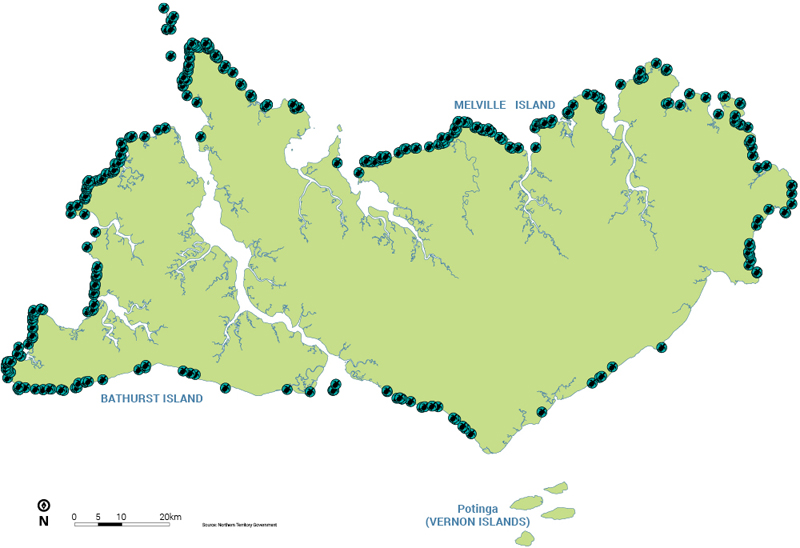Sea Turtles
Tiwi people have strong cultural and subsistence links to sea turtles. Green turtles are the main turtles harvested in the water while eggs of all sea turtle species are collected. Traditional hunting mainly takes place close to communities, leaving most of the islands free from harvest pressure. Olive Ridley turtles (Lepidochelysolivacea)are the most common species nesting on the Tiwi Islands, but Flatback turtles (Natator depressus) and Green turtles (Cheloniamydas) have also been found.
Olive Ridley turtles are the least studied sea turtle species in Australia and are classified as endangered at the national level in regulations of the Commonwealth Environment Protection and Biodiversity Conservation Act. They nest in April and May on remote beaches across the Northern Territory and western Cape York Peninsula in Queensland, and the Tiwi Islands rookeries are among the largest in Australia.
Ensuring turtle populations remain healthy in the long-term is very important to Traditional Owners and since 2003 the Tiwi Land Council has partnered with a range of organisations to study Olive Ridley turtles. This important research, which has been conducted at Imalu Beach at Cape Van Diemen on the north-west coast of Melville Island, has made a significant contribution to knowledge about the ecology of Olive Ridley turtles in Australia.
Areas of Research
Nesting biology
Data was collected on peak nesting times, the number, species, size and weight of nesting adult turtles, and the number or turtles laying eggs. The same turtles were recorded several times over a number of years, indicating a high degree of faithfulness to Imalu beach.
Eggs and hatchlings
Data was collected on the number of eggs per nest, size and weight of eggs and emerging hatchlings, and the number of emerging hatchlings.
Satellite tracking
Satellite trackers were attached to turtles after they laid their eggs to provide information about migration routes, links between nesting beaches and foraging behaviour. Turtles were recorded migrating up to 1000 kilometres after nesting.
Population health
Laparoscopy was used to assess the reproductive condition of turtles and estimate breeding recruitment rates. The number of new breeders arriving each year was 20 per cent, indicating a healthy population.
Predation
Predation significantly impacts turtle populations. Feral dogs, dingos, sea birds, and goannas all eat turtle eggs and prey on hatchlings. Saltwater crocodiles prey on both hatchlings and adults.
Community education
A community education program involving schools and the community helped raise awareness about sea turtles on the Tiwi Islands. In partnership with local primary schools, sea turtle information was incorporated into the curriculum, students assisted researchers on nesting beaches and undertook a range of turtle-themed educational activities. The program culminated in a Turtle Dreaming Camp for students and the broader community.
Sea Turtle Locations and Breeding Sites

Where to from here?
Sea turtles are expected to be particularly threatened by rapid climate warming and rising sea levels. The Tiwi Land Council is partnering with scientists to investigate the effects of increased temperatures and nest inundation on hatchling sex ratios and turtle hatchling performance. Research will continue to inform future turtle management work undertaken by the Tiwi Land Council.
Further reading
Sea Turtle Conservation and Education on the Tiwi Islands

